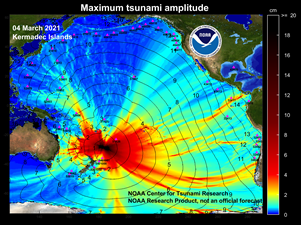Not an official forecast
Kermadec Islands Tsunami, March 4, 2021
Main Event Page
|
The March 4, 2021, Kermadec Islands tsunami was generated by a Mw 8.1 earthquake (29.735°S 177.282°W), at 2021-03-04 19:28:32 UTC (according to the USGS). 45 minutes later, the tsunami was recorded offshore at newly deployed DART 4G 5401001, located approximately 703.2 km away from the epicenter. For the first time, a DART inversion was performed with the data from a New-Zealand-owned DART buoy with 4G capabilities. The largest coastal tsunami amplitude was ~70 cm and was detected at the Kingston, Norfolk Island (Australia) tide station 3 hour 15 minutes after the earthquake. Model results shown below were created with the NOAA forecast method using the MOST model via inversion of the source with NOAA's TFS (Tsunami Forecast System). The graphics display preliminary modeling analysis, showing qualitative and quantitative information about the tsunami, including tsunami wave interaction with ocean floor bathymetric features, and neighboring coastlines. Tsunami model amplitude information is shown color-coded according to the scale bar.
Preliminary Model Comparison of the March 4, 2021 Kermadec Islands tsunami recorded at tsunameter/DARTs and tide gauges (black) with model results computed using the DART-inverted source (red) solution is presented in the graphics. The DART model time series are obtained from the pre-computed generation/propagation forecast database in real time, after automatically fitting models to tsunami records from the DARTs.
It is noted that all above model results are preliminary. The tsunami source is estimated from inversion of observed waveforms at DARTs using a limited number of unit sources. The discrepancies between model results and tide gauge observations are mostly due to 1) the limited knowledge of the earthquake/tsunami source configuration at this point, and 2) the data quality and the low resolution of the bathymetry for locations where no forecast models are available in the NOAA TFS: Kingston Norfolk, North Cape, Tauganra, East Cape, Great Barrier Island, Gisborne, Wellington, Chatham Island, Mare Island, La Libertad, which were created on-the-fly using the low-resolution global relief DEM combined with the SRTM 90-m topography. |
||||
Disclaimer: The models on these pages show the results of ongoing research to enhance tsunami science and to improve NOAA operational tsunami forecasts. These products were developed during or shortly after the tsunami event, are intended for research use, and are not an official forecast. They should not be used as the basis of any public or private policy decisions. Please contact NCTR to find if there are more detailed follow-on analysis results.
For media inquiries:
When using information from this page, please credit NOAA / PMEL / Center for Tsunami Research


